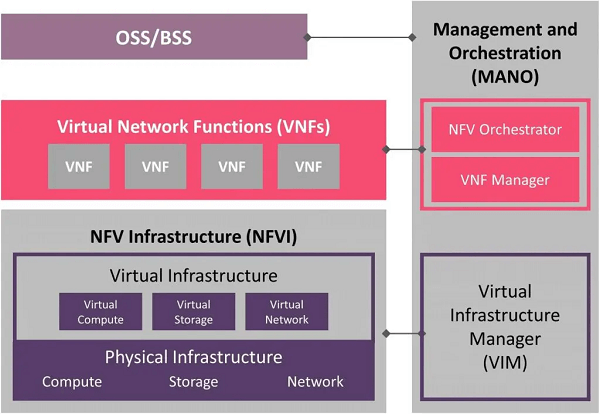Network Function Virtualization (NFV): transforming Network Architecture with Virtualized FunctionsWhat is Network Function Virtualization?Network functions virtualization (NFV) is an approach to network architecture that involves replacing dedicated network hardware devices with software-based virtualized network functions (VNFs) that run on standard servers, storage, and switches. In traditional networking, specialized hardware devices such as routers, firewalls, and load balancers are used to perform specific network functions. With NFV, these functions are virtualized and can be run as software on commodity hardware, leading to greater flexibility, scalability, and cost-effectiveness. NFV enables network operators to quickly and easily deploy and scale network functions as needed, without the need for physical hardware installation or maintenance. By virtualizing network functions, operators can also reduce their capital and operational expenditures, and increase their network agility, flexibility, and scalability. NFV is often used in conjunction with software-defined networking (SDN), another approach to network architecture that separates the control plane and data plane of the network, allowing for centralized network management and orchestration. Together, NFV and SDN enable network operators to build more agile and efficient networks that can adapt to changing business and user requirements. History of Network Function Virtualization (NFV)The concept of network functions virtualization (NFV) emerged in 2012, when a group of leading telecommunications service providers, including AT&T, Deutsche Telekom, and NTT Docomo, formed the NFV Industry Specification Group (ISG) under the auspices of the European Telecommunications Standards Institute (ETSI). The goal of the NFV ISG was to develop a framework for virtualizing network functions and deploying them on industry-standard servers, storage, and switches, with the aim of improving network agility, flexibility, and cost-effectiveness. The NFV ISG released its first set of specifications in 2013, defining the requirements and architecture for virtualized network functions. Since then, NFV has gained widespread adoption across the telecommunications industry, with many service providers and vendors developing and deploying NFV solutions. In 2015, the ETSI released a second set of NFV specifications, expanding on the original framework and addressing topics such as security, management and orchestration, and network slicing. Today, NFV is considered a key enabler of the emerging 5G network architecture, providing a flexible and efficient way to deploy and manage the wide range of network functions and services needed to support the diverse use cases and applications of 5G. In addition to the ETSI NFV ISG, other industry groups and organizations have developed standards and best practices for NFV, including the Open Network Automation Platform (ONAP), the Open Platform for NFV (OPNFV), and the Linux Foundation Networking (LFN) project, among others. How does network functions virtualization work?Network functions virtualization (NFV) works by virtualizing network functions that were traditionally performed by specialized hardware devices, such as routers, switches, firewalls, and load balancers. These network functions are abstracted from their underlying hardware and implemented as software-based virtual network functions (VNFs) that run on standard servers, storage, and switches. NFV is typically implemented using a virtualization layer that allows multiple VNFs to run on the same physical infrastructure. This virtualization layer provides isolation between the VNFs, enabling them to run independently of each other, and also provides resource management and allocation, ensuring that each VNF gets the resources it needs to operate effectively. Components of NVF architecture:The NFV architecture typically includes the following components: 
Overall, NFV enables organizations to deploy network functions more quickly and cost-effectively while also providing greater flexibility, scalability, and agility. By virtualizing network functions, operators can create a more dynamic and efficient network architecture that can adapt to changing business and user requirements. Benefits of Network Function Virtualization:There are several benefits to using Network Function Virtualization (NFV) in modern network architectures. Here are a few key reasons why organizations may choose to adopt NFV:
Overall, NFV provides a flexible, scalable, and cost-effective approach to network architecture, allowing organizations to build more agile, efficient, and innovative networks that can adapt to changing business and user requirements. Risk of Network Function VirtualizationWhile there are many benefits to network functions virtualization (NFV), organizations should consider some risks and challenges before implementing NFV. Here are a few potential risks of NFV:
Overall, while NFV can offer significant benefits in terms of cost savings, agility, and flexibility, organizations should carefully consider the potential risks and challenges before implementing this technology in their networks. They should also ensure that they have the right expertise, tools, and processes in place to successfully deploy, manage, and secure their NFV environments.
Next TopicNetwork-Layer Security | IPSec Modes
|
 For Videos Join Our Youtube Channel: Join Now
For Videos Join Our Youtube Channel: Join Now
Feedback
- Send your Feedback to [email protected]
Help Others, Please Share









